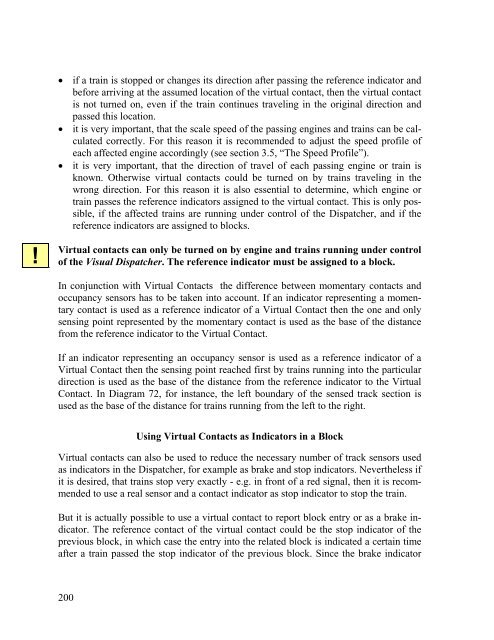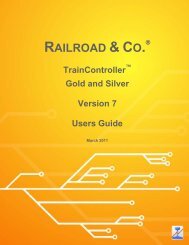Download - Freiwald Software
Download - Freiwald Software
Download - Freiwald Software
You also want an ePaper? Increase the reach of your titles
YUMPU automatically turns print PDFs into web optimized ePapers that Google loves.
!<br />
• if a train is stopped or changes its direction after passing the reference indicator and<br />
before arriving at the assumed location of the virtual contact, then the virtual contact<br />
is not turned on, even if the train continues traveling in the original direction and<br />
passed this location.<br />
• it is very important, that the scale speed of the passing engines and trains can be calculated<br />
correctly. For this reason it is recommended to adjust the speed profile of<br />
each affected engine accordingly (see section 3.5, “The Speed Profile”).<br />
• it is very important, that the direction of travel of each passing engine or train is<br />
known. Otherwise virtual contacts could be turned on by trains traveling in the<br />
wrong direction. For this reason it is also essential to determine, which engine or<br />
train passes the reference indicators assigned to the virtual contact. This is only possible,<br />
if the affected trains are running under control of the Dispatcher, and if the<br />
reference indicators are assigned to blocks.<br />
Virtual contacts can only be turned on by engine and trains running under control<br />
of the Visual Dispatcher. The reference indicator must be assigned to a block.<br />
In conjunction with Virtual Contacts the difference between momentary contacts and<br />
occupancy sensors has to be taken into account. If an indicator representing a momentary<br />
contact is used as a reference indicator of a Virtual Contact then the one and only<br />
sensing point represented by the momentary contact is used as the base of the distance<br />
from the reference indicator to the Virtual Contact.<br />
If an indicator representing an occupancy sensor is used as a reference indicator of a<br />
Virtual Contact then the sensing point reached first by trains running into the particular<br />
direction is used as the base of the distance from the reference indicator to the Virtual<br />
Contact. In Diagram 72, for instance, the left boundary of the sensed track section is<br />
used as the base of the distance for trains running from the left to the right.<br />
200<br />
Using Virtual Contacts as Indicators in a Block<br />
Virtual contacts can also be used to reduce the necessary number of track sensors used<br />
as indicators in the Dispatcher, for example as brake and stop indicators. Nevertheless if<br />
it is desired, that trains stop very exactly - e.g. in front of a red signal, then it is recommended<br />
to use a real sensor and a contact indicator as stop indicator to stop the train.<br />
But it is actually possible to use a virtual contact to report block entry or as a brake indicator.<br />
The reference contact of the virtual contact could be the stop indicator of the<br />
previous block, in which case the entry into the related block is indicated a certain time<br />
after a train passed the stop indicator of the previous block. Since the brake indicator










